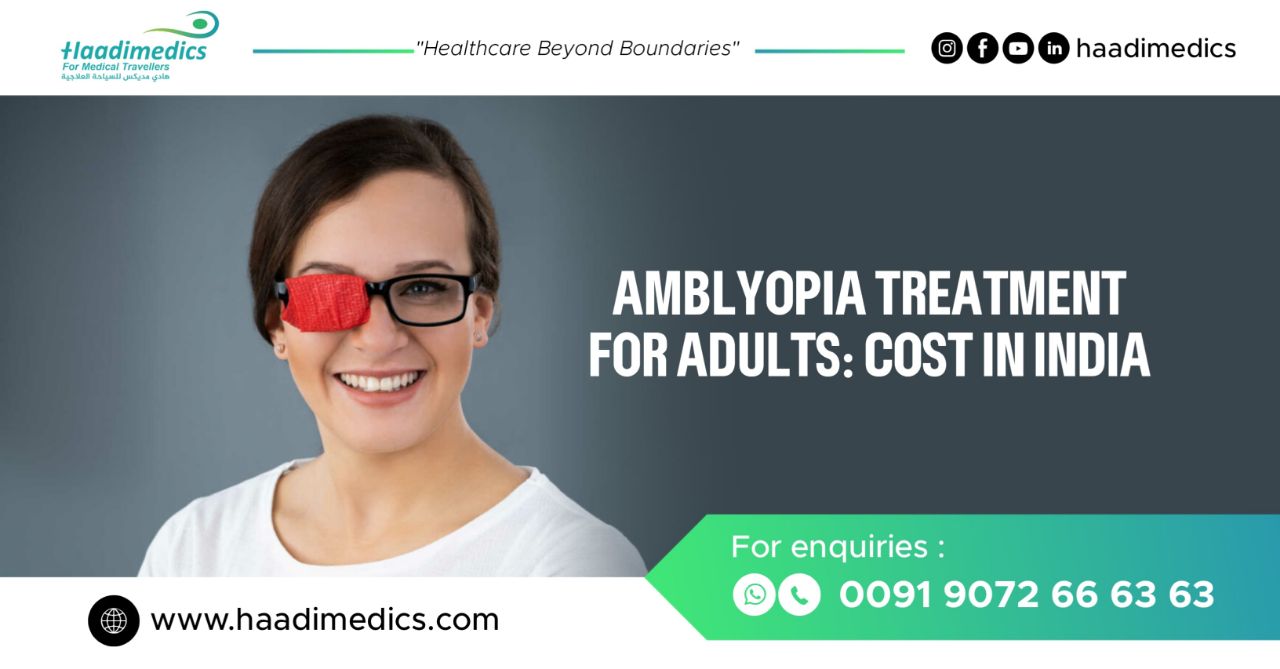India has made glorious steps in the treatment of amblyopia, also known as "lazy eye," offering advanced therapies and experienced ophthalmologists. With cutting-edge technology and a focus on patient care, Indian hospitals have become renowned for their success in treating amblyopia in adults.
Understanding Amblyopia
Amblyopia is a vision disorder characterized by reduced vision in one or both eyes, often due to abnormal visual development during infancy or childhood.
Common symptoms include poor depth perception, squinting, and difficulty with fine visual tasks. While amblyopia is typically diagnosed and treated in childhood, it can also affect adults, albeit with more challenging treatment outcomes.
Why is Amblyopia Treatment done?
Amblyopia treatment aims to improve vision in the affected eye(s) and restore binocular vision when possible. In adults, amblyopia treatment is essential to enhance visual function, prevent further deterioration, and improve quality of life. Treatment may also be pursued for cosmetic reasons, as amblyopia can result in misaligned eyes (strabismus) or other aesthetic concerns.
Risks Associated with Amblyopia Treatment
While amblyopia treatment is generally safe, it may involve certain risks and considerations:
1. Limited Improvement: In some cases, amblyopia treatment in adults may result in limited improvement in visual acuity, particularly if the condition is long-standing or severe.
2. Relapse: Without ongoing maintenance therapy, there is a risk of relapse following successful amblyopia treatment, necessitating long-term monitoring and follow-up care.
3. Side Effects: Certain treatment modalities, such as occlusion therapy or pharmacologic treatment, may cause temporary side effects such as eye discomfort, irritation, or blurred vision.
Preparation for Amblyopia Treatment
Preparation for amblyopia treatment typically involves:
1. Comprehensive Eye Examination: Adults undergoing amblyopia treatment undergo a comprehensive eye examination to assess visual acuity, refractive errors, and the presence of any underlying eye conditions.
2. Discussion of Treatment Options: Patients consult with their ophthalmologist to discuss various treatment options, which may include occlusion therapy, pharmacologic treatment, vision therapy, or a combination of approaches.
Procedures
Treatment options for amblyopia in adults may include:
1. Occlusion Therapy: Patching or covering the stronger eye to encourage the use of the amblyopic eye and stimulate visual development.
2. Pharmacologic Treatment: The use of atropine eye drops to blur vision in the stronger eye and promote visual acuity in the amblyopic eye.
3. Vision Therapy: Customized exercises and activities aimed at improving visual skills, such as eye coordination, depth perception, and visual processing.
Best Hospitals in India for Amblyopia Treatment
- Medanta - The Medicity, Gurgaon
- Max Hospital, Delhi
- Aster Medcity, Kochi
- Indraprastha Apollo Hospital, New Delhi
- Artemis Hospital, Gurgaon
- Aravind Eye Hospital, Madurai
- Sankara Nethralaya, Chennai
- LV Prasad Eye Institute, Hyderabad
- Shroff Eye Centre, Delhi
- Narayana Nethralaya, Bangalore
Best Doctors for the Treatment
- Dr. Dharitri Samantaray
- Dr. Deependra V Singh
- Dr. Pratik Ranjan Sen
- Dr. Sunaina Arora
- Dr. Dheeraj Gupta
- Dr. Vandana Khullar
Cost Comparison
India – INR 30000 (USD 359)
Turkey – USD 4000
Thailand – USD 4000
FAQ
1. Is amblyopia treatment effective in adults?
While amblyopia treatment may be less effective in adults compared to children, significant improvements in visual acuity and function can still be achieved with appropriate therapy and adherence to treatment regimens.
2. Can amblyopia treatment improve depth perception in adults?
Yes, amblyopia treatment, particularly vision therapy and binocular vision training, can help improve depth perception and spatial awareness in adults with amblyopia.
3. How long does amblyopia treatment take to show results?
The duration of amblyopia treatment and the time to see improvement in visual acuity can vary depending on factors such as the severity of amblyopia and the chosen treatment modality. Patients may start noticing improvements within a few weeks to several months of initiating treatment.
4. Can amblyopia treatment be done without surgery?
Yes, amblyopia treatment for adults typically does not require surgical intervention. Non-surgical approaches such as occlusion therapy, pharmacologic treatment, and vision therapy are the mainstay of treatment.
5. Is amblyopia treatment covered by health insurance?
In some cases, health insurance plans may cover a portion of the cost of amblyopia treatment, particularly if it is deemed medically necessary. Patients are advised to check their insurance coverage and consult with their provider for details.
6. Can amblyopia treatment be successful in adults with long-standing vision issues?
While early intervention is ideal for amblyopia treatment, adults with long-standing vision issues can still benefit from therapy. Success rates may vary depending on the severity of the condition and individual response to treatment.
7. Is amblyopia treatment painful or uncomfortable?
Amblyopia treatment modalities such as occlusion therapy or pharmacologic treatment are generally well-tolerated and painless. Patients may experience mild discomfort or irritation initially, but this usually resolves with time.
8. Are there any lifestyle changes or precautions to follow during amblyopia treatment?
Maintaining regular follow-up appointments, adhering to the prescribed treatment regimen, and protecting the eyes from injury are essential during amblyopia treatment. Patients may also be advised to limit screen time and maintain overall eye health.
9. Can amblyopia treatment improve visual acuity in both eyes?
While the primary goal of amblyopia treatment is to improve vision in the affected eye, some patients may experience modest improvements in visual acuity in both eyes, particularly with comprehensive therapy and visual rehabilitation.
10. What is the success rate of amblyopia treatment in adults?
Success rates for amblyopia treatment in adults vary depending on factors such as the severity of amblyopia, treatment compliance, and the chosen therapeutic approach. With proper diagnosis and management, many adults can achieve significant improvements in visual function and quality of life.


Comments